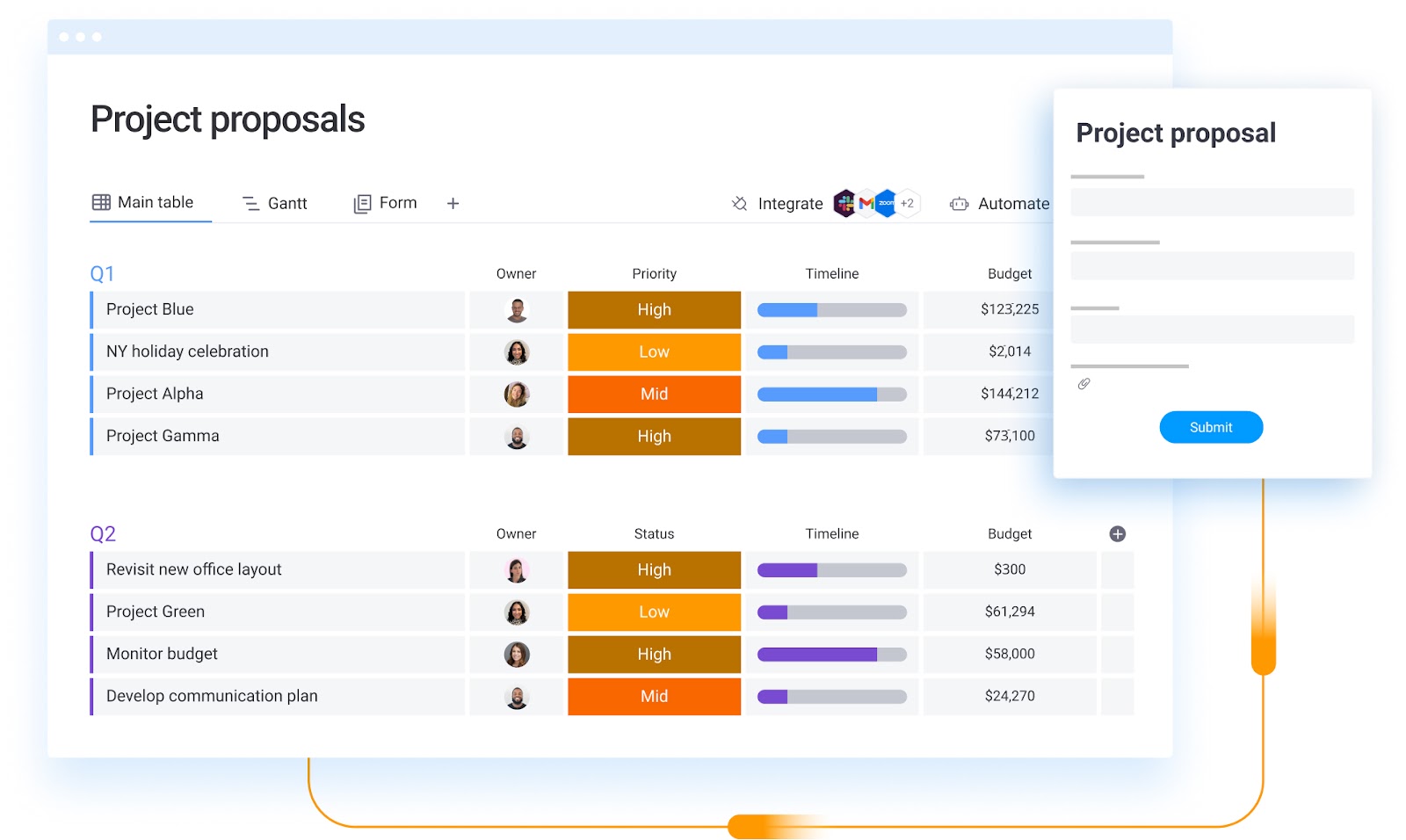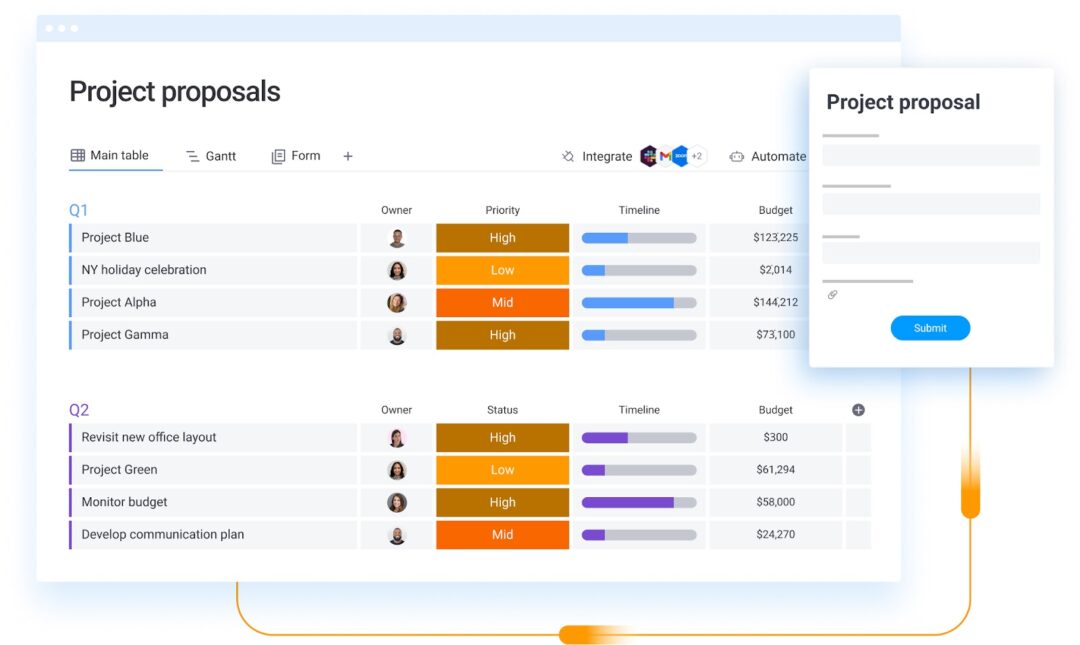Make every project handoff a win with monday.com
Blog: Monday Project Management Blog
In a relay race, the baton passing between athletes needs to happen at a precise moment to keep the race moving. Effective planning, great communication, and trust between team members make all the difference in this situation. When it comes to project work that’s passed to another team or a client, it’s a lot like running in a relay race.
In this guide, we’ll look at the steps every project team should follow to ensure project handoffs result in happy teammates and satisfied customers.
What is a project handoff?
In simple terms, a project handoff is passing project work to another team. A clear enough statement, but in practice, a good project handoff takes some planning — it’s not a process that happens in a day. A good handoff entails a thoughtful approach that doesn’t leave the team on the receiving end in a state of disarray.
The goal of any project handoff is to ensure that the next team can continue to work smoothly and successfully, with minimal disruptions or delays.
Handoffs can occur during:
- Client delivery: The most common handoff, client delivery requires considerable planning to ensure a smooth transition and high satisfaction.
- Normal project progression: Some projects require multiple teams working in succession, where one team’s work doesn’t start until a previous team’s efforts are complete.
- Stakeholder changes: If projects undergo considerable management or team changes mid-cycle, smooth handoffs are necessary to prevent excessive disruption to the project plan.
In other words, handoffs are common in project management. In theory, a handoff is closing one stage of a project’s life cycle and beginning another. Any problems during this transition can cause problems far into the project’s future, so it’s essential to make smooth transitions.
Doing this requires teams to evaluate a project’s unique requirements. Much of what determines a handoff strategy depends on the kind of handoff you’re doing and the nature of the project. Let’s explore the process in detail through an example to understand better.
Real-world examples of project handoffs
Let’s imagine that you and your team are developing new software for a client that’s expanding in their market. They’ve entrusted you to deliver a solution that helps them optimize their efforts, and the project is close to concluding. While it’s easy to think of this kind of project as complete once development is done, that’s not the case.
Even when your team’s work wraps, the project is still progressing — it’s moved from development to production. So both the project team and the client must be clear on expectations and the details of the project handoff. This alignment of expectations is fundamental and for most teams, the finer points are defined from the very beginning of a project:
- A detailed outline of the deliverables the client will receive
- What steps the team and client will take once the project team’s work concludes
- Expectations of support and assistance from the project team once the handoff is complete
- A timeline for project completion and for the handoff process
You can probably see how this transitional period in a project’s life cycle can affect client relationships in big ways, for better or worse, which is why smooth handoffs are essential.
How does a project handoff affect client relationships?
When a client knows what to expect, and who’s responsible for what if an issue arises, it improves their perception of your team. By providing a clear and organized transfer of information and assets, your team demonstrates its attention to detail and commitment to delivering high-quality work.
By ensuring all the necessary information and assets are in their hands, the team demonstrates its commitment to the client’s success. Since a smooth handoff helps improve the client’s trust and confidence, they’re much more likely to remain a loyal customer. But this is only one of the many benefits.
Benefits of a smooth project handoff
Well-executed handoffs help minimize disruptions and keeps projects moving gracefully from one team to the next. The benefits of this fluid momentum include:
- Better efficiency: With a smooth handoff, the next team can begin work immediately instead of spending time figuring out what comes next.
- Higher quality: A great project pass means a successful transfer of all the information the next team needs, which helps prevent mistakes and improves the project’s overall quality.
- Improved teamwork: Whether it’s to an internal team or a client, good handoffs require strong collaboration. A team that focuses on well-executed handoffs is one that excels at communication and teamwork.
When it comes to a project, it’s easy for teams to get caught up in planning and execution and forget about the importance of a handoff. But as we’ve seen, a successful handoff, which is part and parcel of a project closeout, might be one of the most critical aspects of any project. Take the time to learn the steps of a smooth handoff.
Steps for a successful project handoff
The steps necessary for a successful handoff vary considerably depending on the type of handoff and on the kind of project being transferred. That said, there are three steps, applicable to nearly any situation, that will improve handoffs:
- Define the details: The first step is defining what’s being handed off, including information about the project itself, the assets being passed, and any necessary documentation on using the assets. It should also include information about the roles and responsibilities of everyone involved and any necessary procedures for unexpected events.
- Have a discussion: Before beginning a handoff, a meeting between key stakeholders to hash out the finer points helps ensure a smooth ride for everyone on board. This is also a good opportunity to review any procedures outlined in the first step.
- Pass the baton: Finally, you can pass the project on to the next team. This stage will look different for every project, though the highest aim is to prevent any surprise moments and eliminate uncertainties.
The key to smooth handoffs is clear communication and coordination between teams regardless of the project or the teams involved. Great work management tools that simplify sharing and collaborating don’t hurt either.
Using monday.com to manage project handoffs

Regarding team alignment, keeping every stakeholder in the loop is second nature with monday.com. Between real-time collaboration, notifications, and powerful automation, you can ensure every team member and detail is ready when it’s time to hand over a project.
That same level of collaboration extends to transitional teams, whether in the same organization or a client project your business needs to deliver. The boards that power your team’s efforts are easily sharable with the handoff team, so you can ensure everyone’s on the same digital page. And with chart views, integrated messaging, and color-coded statuses, everyone involved can track and discuss the handoff in real-time.
Frequently asked questions
To add a little more context to the concept of project handoffs, here are answers to a couple of frequently asked questions on the topic:
What is a project handoff?
A project handoff is a process of transferring ownership or control of a project from one team to another. It could include the transfer of assets, resources, documentation, and even intellectual properties. In some cases, it also involves training and guidance after the initial transfer.
What are the five stages of the PM life cycle?
The five stages of the project management life cycle are:
- Initiation: During the first stage of the PM life cycle, you define a project’s goals and scope and develop the project plan.
- Planning: Next, you define the project’s tasks, timeline, and resources and develop risk mitigation strategies.
- Execution: During this stage, project managers coordinate teams to carry out activities according to the project plan.
- Monitoring and control: This stage involves regularly reviewing the project’s performance and making any necessary adjustments to the plan.
- Closure: This is the final stage of the project management life cycle, where the project is formally concluded, and all activities and tasks are completed.
Passing the project baton
There’s a reason that the allusion to relay racers passing the baton is such a prevalent idiom. Transitional periods, where responsibility moves from one to another, are moments of truth, whether it’s a literal race or a project moving on to another stage. Thoughtful planning, no less than a careless misstep, can have long-lasting impacts on the success of your projects. So lace up your new Work OS and give your project an Olympic-level handoff.
The post Make every project handoff a win with monday.com appeared first on monday.com Blog.
Leave a Comment
You must be logged in to post a comment.








